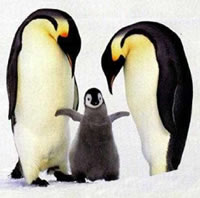|
Volume 4, Issue 3
February 14 , 2006
Antarctica
WELCOME! to Education World's Early Childhood Newsletter. Every other week, I'll share some
ideas on a familiar teaching theme. Hopefully you will find a new activity idea or two -- or a new
twist on one of your old favorites! Since I know you are very busy, I'll be short and sweet -- like
most of activities I suggest.
Tell a friend about us! Invite them to sign up for their own FREE subscription at /newsletter_form
 In
many places, this time of year can bring freezing temperatures -- temperatures that invite us to
discuss with young children the clothing we wear in cold weather, how we get snow, or how animals
stay warm and find food when chilly winds blow. With that in mind, this issue suggests some activities
and ideas that relate to cold -- specifically the coldest place on Earth, Antarctica. So bundle
up and warm your hands for some chilly classroom fun! In
many places, this time of year can bring freezing temperatures -- temperatures that invite us to
discuss with young children the clothing we wear in cold weather, how we get snow, or how animals
stay warm and find food when chilly winds blow. With that in mind, this issue suggests some activities
and ideas that relate to cold -- specifically the coldest place on Earth, Antarctica. So bundle
up and warm your hands for some chilly classroom fun!
Susan LaBella
Editor, Early Childhood Education Newsletter
TEAR A PICTURE
Read to children The Emperor's Egg: Read and Wonder, by Martin Jenkins (Candlewick Press).
After reading, talk with children about the location of Antarctica (on a globe), explaining that
it is the coldest place on Earth, with lots of ice and chilling winds. Give children torn bits of
white, blue, and black construction paper. Provide each child with a white sheet of construction
paper and paste. Encourage students to use the torn paper to create a picture of Antarctica including
frozen land, water, and penguins. Invite each child to dictate a sentence about his or her picture
as you record it at the bottom of the paper.
AS COLD AS...
After talking about the characteristics of Antarctica (cold, windy, icy, snowy) introduce children
to similes. Begin by providing the first part of a simile and inviting children to take turns completing
it: The snow is as white as ______. Once children get the idea, list more beginning similes
on an easel pad:
The wind is as cold as...
The ice is as slippery as...
The water is as dark as...
Then encourage students to choose a simile to complete. Record each student's completed phrase on
a piece of drawing paper and have students illustrate their similes.
BRRRRRRRRR!!
Ask students how animals such as whales, seals, and penguins might stay warm in the cold Antarctic
waters. Introduce the word "blubber" and explain that it is a thick layer of fat that
helps keep these animals warm. Invite students to try this experiment. Have each student put a plastic
glove on one hand and insert that hand into another plastic glove filled with solid shortening.
Knead the shortening to distribute it evenly around the hand. Cover each student's other hand with
two plastic gloves. Invite students to place both hands in a bucket of ice-cold water. Ask, which
hand gets cold faster? Explain that the shortening acts like the blubber in Antarctic animals; it
helps to keep them warm.
SWEET PENGUINS
Make this sweet penguin snack for your children. Twist apart a chocolate sandwich cookie. Leave
the bottom side on a paper plate. Break the top part of the cookie in two pieces, placing one piece
on either side of the bottom cookie for wings. Add a chocolate drop to the top for the head and
beak.
WHICH IS YOUR FAVORITE?
Share with children the slide penguin slide show at:
https://www.kidzone.ws/animals/penguins/photos.htm
Discuss with children some different kinds of penguins including the Emperor, Adelie, Gentoo, and
Chinstrap. On an easel pad create a large simple graph, entering each penguin name down the left-hand
side. Invite children to vote on their favorite penguin. Each child can enter a vote by coming forward
and marking an X across from the correct penguin name. (You may want to add vertical lines to your
graph to help child find their places.) Help child review their graph, asking questions such as:
Which penguin got the most votes? The least votes? And so on.
LET'S SKATE
Help children understand what Antarctic ice can be like with this activity. Tape onto the floor
several lengths of clear, heavy-duty plastic. Invite children to take off their shoes and
-- skate on it;
-- waddle like penguins on it;
-- slide like a seal using their arms as flippers.
Check out the following Web sites for additional background and activities.
 Australian
Antarctic Division Picture Gallery Australian
Antarctic Division Picture Gallery
Introduce students to the animals that live in the coldest place on Earth!
http://www.aad.gov.au/default.asp?casid=5590
America Zoo
Children will enjoy the wonderful photos and information on this site.
http://www.americazoo.com/kids/antarctica.htm
Penguin Themed Coloring Pages
Find loads of penguin coloring pages to print out here.
http://www.coloring.ws/penguins1.htm
Little
Penguin Finds His Way Home
A lesson plan based on a story from Sea World.
http://www.seaworld.org/just-for-teachers/guides/ocean-friends/littlepen...
ChildFun Family
Website
The octopus and whale both swim in the cold Antarctic waters. Here you'll find some fun activities
for both of these animals and many more.
http://www.childfun.com/modules.php?name=Content&pa=showpage&pid=6
|